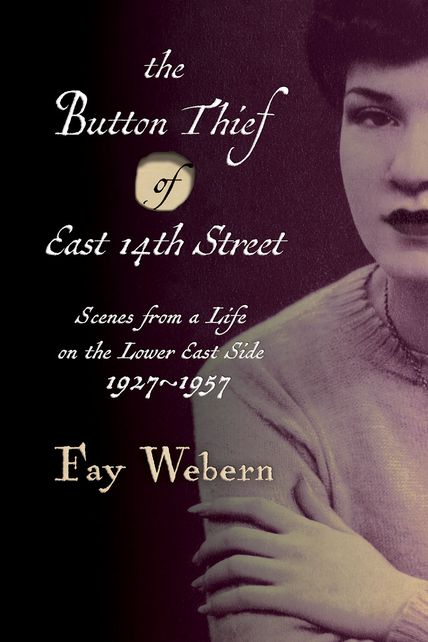The Button Thief of East 14th Street
“Fay Webern has performed a kind of magic trick, conjuring a seemingly lost world by means of memory, language, and a handful of photos… I love this book.“
Adam Sexton, author of Master Class in Fiction Writing
From the tenements and crowded marketplaces of the Lower East Side to the exhilarating post-war years of jazz and modern art…
The vanished world of Lower East Side comes alive in The Button Thief of East 14th Street, Fay Webern’s extraordinary coming-of-age chronicle of her life in New York City during the turbulent years of the Great Depression and the Second World War.
As seen through the eyes of a observant young girl growing up in the neighborhood, this detailed personal narrative vividly evokes all the struggles, humor and heartbreak of life in this tight-knit immigrant community.
Elegantly crafted, lively and intimate, this beautiful book captures the true heart of New York.
Born to Russian-Jewish immigrants in 1927, just two years before the Stock Market Crash of 1929, Fay was the youngest of four in a close-knit family plagued by financial hardship.
Her father, a skilled garment worker paid by the piece, often struggled to provide for his family and his constant money anxieties sometimes made him secretive and stingy.
Her mother, headstrong and ever-resourceful, made up the difference, relentlessly scouting out opportunities to bring home extra money for her family, peddling peanuts, plucking chickens, selling leather shopping bags to well-dressed women browsing in the crowded market stalls of Orchard Street.
Indeed, it was due to her mother’s perseverance and ingenuity that the family moved into Lavanburg Homes, a remarkable experiment in public housing, which combined the American utopian housing ideal with the English settlement house movement of teachings crafts and skills.
Fay’s Lower East Side: the Gypsy October festivals where Jews flock to buy wild Concord grapes for Passover wine, the sprawling chicken market tucked inside a pillar of the Williamsburg Bridge, the Election Night fires — and the back room poker games at the candy store across the street, where Fay waited for her mother after school, earning good money with tips given to her by winning players.
As Fay entered adolescence and young adulthood, she was naturally drawn to the Bohemian world of the emerging post-war New York arts scene, a flourishing American renaissance of jazz, painting, dance, and literature.
Click here to order The Button Thief of East 14th Street
“In The Button Thief of East 14th Street, Fay Webern has performed a kind of magic trick, conjuring a seemingly lost world by means of memory, language, and a handful of photos. Spanning New York’s Lower East Side from the East River to the fringes of Greenwich Village, from the Great Depression through the Second World War and beyond, Webern’s rigorously unsentimental memoir demonstrates definitively that it takes a village — or in this case, a utopian housing project for low-income workers — to raise a child.
I love this book.”Adam Sexton,
Author of Master Class in Fiction Writing
“It’s amazing that well into the 21st century, we have been graced with this bittersweet, compelling, and often hilarious memoir of the Jewish Lower East Side during the thirties and the post-war era. Fay Webern’s detailed portrait of this bustling neighborhood of immigrants, shops and overcrowded tenements brings to mind the work of the great Jewish writer Anzia Yezierska, although Webern has a sharper eye, and is less prone to sentimentality.
With wit and affection, Webern vividly evokes the progressive housing project her family moved into, and its eventual demolition. Webern’s unique personal story draws us into the very heart of the New York story, revealing the evolving experience of this influential immigrant community, so often mythologized but not always understood.”
David Winner,
Author of The Cannibal of Guadalajara and Tyler’s Last
“Webern’s minutely detailed memoir of growing up Jewish in downtown Manhattan from the 1930s through the early ’50s excellently evokes an era of pushcarts and projects, of hard times and harsh realities. Although the author doesn’t romanticize her memories, she drenches her anecdotes in affection. Even when her nearest and dearest are behaving their worst (as they often are), Webern writes with an eye for forgiveness — or at least understanding — and not judgment; that’s not to say she’s a pushover, but much of what she says comes with an Old World-style shrug …there’s a disarming naïveté in the way she talks about her mother’s various scams or how she earned her own “button thief” moniker. Every once in a while, she catches readers up short with the sheer, unaffected beauty of her observations.“
Kirkus Reviews
“An important record of historical witness, and an astonishingly beautiful work of literature.“
Tyler C. Gore,
Author of My Life of Crime (forthcoming)
“The accompanying photographs on the release captured the dramatic aura and energy that Webern exudes: her regal, chiseled features and beautifully expressive hands commanded immediate attention. The images suggested that this woman was a natural performer and storyteller, a first impression that was confirmed when I later met her…
“[Webern’s] written work gives voice to the strong women who kept her family alive, before, during, and after the Great Depression….
“The year Webern was born, the fourth child in her struggling, low-income family, her entrepreneurial mother negotiated their move out of their squalid flat on Avenue D into the Lavanburg Homes, the first “utopian” housing community designed specifically for low-income families. Webern gives a vivid description of life at Lavanburg in her memoir, which she calls “novelistic nonfiction” rather than “creative nonfiction” […] Webern’s ability as a storyteller continues to engage and inspire enthusiastic audiences of all ages.“
Cynthia Close, Vermont Woman
Click here to order The Button Thief of East 14th Street
